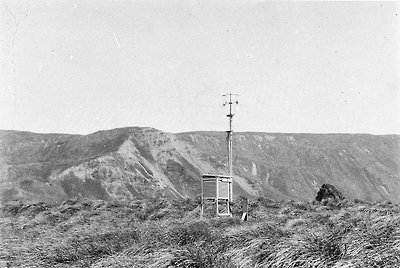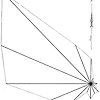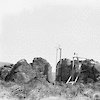Changing skies
In their own words
The average relative humidity for the four months ending April 30 was 93 per cent., leading to copious condensation on the instruments exposed to the air. It was necessary, therefore, constantly to attend and frequently clean the thermographs, hygrometers and the wireless plant.
— George Ainsworth in The Home of the Blizzard
George Ainsworth was an officer of the Commonwealth Meteorological Bureau attached to the AAE for the duration of the expedition, so responsibility for collection of weather data naturally fell to him. He put aside a couple of hours each day to record hourly pressure and temperature readings along with ‘descriptive remarks, averages and other details required to be summarized’.
The various meteorological instruments were set up in suitable places on the Isthmus, so the work kept Ainsworth in permanent residence at the Shack, the main AAE hut on the is land. The barometer and barograph were in the living hut, about nine metres above sea-level. The standard Commonwealth thermograph screen, measuring temperature, was close to the Hut, with wind recording instruments — an anemograph and a ‘Robinson-type’ cup-anemometer — in a suitably exposed spot further away, secured to rocks.
Daily weather reports for Macquarie Island were telegraphed to Melbourne and (from May 1912) Hobart. From 12 May 1912 a daily weather report was also sent to Wellington, a service said by the New Zealand meteorologist, DC Bates, to be of ‘immediate value in the issue of daily forecasts’.
Blake and Hamilton also took meteorological records while at Lusitania Bay between August 1912 and January 1913, and Blake made records during field work in the island’s south. Around May 1912, the AAE Scientific Report on meteorology noted, Blake undertook observations of the stars and planets.
Auroras were a frequent occurrence at the island, which is very close to the southern auroral maximum zone. Ainsworth had the additional task of reporting any such occurrence. On such occasions, Charles Sandell noted the effect of auroral activity on wireless transmission, reporting on 14 November 1913 that ‘I have proved to my satisfaction that the aurora in some forms most certainly affects wireless.



